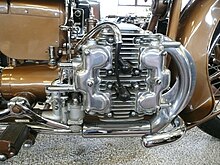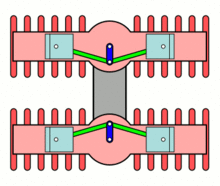H engine
An H-engine is an internal combustion engine with a cylinder arrangement in which the cylinders or rows of cylinders look like a horizontal, large H when viewed in the direction of the crankshafts . An H-engine can be seen as two 180 ° V-engines , coupled one on top of the other . The “two” engines each have their own crankshaft, which is connected and synchronized with gear wheels at the end of the engine from which the power is drawn . It therefore resembles a mixture of a tandem engine and a boxer engine . It is not a double piston engine because the pistons do not act on a common combustion chamber.
Advantages and disadvantages
The cylinder arrangement has a worse power-to-weight ratio than variants with only one crankshaft. For aircraft , an engine that is flat and compact, even with a higher number of cylinders, is advantageous because the frontal area, which is small compared to radial engines, results in less air resistance. Since the common center of gravity of both pistons on a crank (offset) is always in the plane that is determined by the axes of the crank pin, a perfect mass balance can be achieved with rotating counterweights .
commitment
Because of the few advantages over many disadvantages, H engines were used very rarely.
H engines in the motorcycle

H engines in automobiles
- BRM H-16 Formula 1 engine in the BRM P83 . The engine was considered heavy and unreliable, had insufficient torque and a high center of gravity . Jackie Stewart is said to have said of the engine "This piece of metal should be used as a ship anchor rather than as a power unit" .
H engines in airplanes

- Napier Rapier , Dagger and Saber aircraft engines. In contrast to the BRM engine, the Saber was a successful design. Pratt & Whitney developed the X-1800 .
H engines in ships
- At the beginning of the 1970s, the German and French navies worked together to develop a 40-cylinder H engine (40 H 672) for special marine applications. For this, the V-angle of a standard 20-cylinder four-stroke diesel engine was enlarged to 180 ° and two such units were combined into one engine. The two counter-rotating crankshafts transferred their power to a common output shaft. Half of the engine could be switched off to save fuel. However, it remained with a test engine.
Misnamed "H engines"
Subaru has irritatedly marketed water-cooled 4- and 6-cylinder boxer engines as H-4 and H-6, although their cylinder arrangement has nothing to do with a real H-engine. The correct designation would be B4 or B6 (B for boxers).
Saab used the "H" as a type designation for a conventional four-cylinder in-line engine with 2 and 2.3 liters displacement ("H-Motor", H engine, but it was also called B205 or B235).
Web links
- http://boxermotor.com/h-motor.php - More information on the subject

